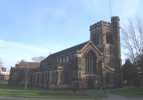For this church:    |
| |||||||||||||||||||||||||
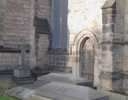 The
door in the south The
door in the southwall of the chancel |
The church was rebuilt under Henry VIII, using stones from the fourteenth century church. A painting exists of the sixteenth century church. It was in late perpendicular architectural style, with a nave, chancel and small tower on the south side. It could accommodate 270 people in enclosed pews, of which only 35 were free and unappropriated. There was a doorway in the south wall of the chancel, used at this time by priests, but it is now blocked by the choir stalls.
138 people died from a total population of 350 in 1593/4 of bubonic plague. They were buried in a pit in the east end of the churchyard, and the vicar Rev William Jefferies recorded their names and dates.
A religious census was held in 1676, which was a time when the religious question was very acute, as Charles II was at the end of his reign and the country was facing the possibility of a Roman Catholic king. The entry for Beeston recorded that 163 persons were of age to receive communion within the parish; none were Popish Recusants or suspected of being such and none were other dissenters refusing or absenting themselves from communion of the Church of England at such time as by law they were required to communicate.
An inventory was taken in June 1735 by the Minister and churchwardens of the books, vestments and vessels of the parish church for a parochial of the Right Worshipful Robert Marsdon, Archdeacon of Nottingham. The inventory notes that there were:
| Books | Two large and great bibles Two large Common Prayer books A smaller Common Prayer book A book of homilies A table of marriages A register of parchment |
|
 |
||
| Vestments | Two surplices A carpet to the Communion table A linen cloth for the Communion table A linen cloth to cover the elements A pulpit cloth and cushion A hearse cloth |
|
 |
||
| Vessels | A silver cup with cover to it Two pewter flagons A salver A basin for the offertory A round pewter plate |
|
The church, except the chancel, was rebuilt in 1843 by Sir George Gilbert Scott. The new church was built to seat 800 and cost approximately £3,500, of which £3,100 was raised by public subscription, thanks to the efforts of the Rev F.T.Wolley. Wolley’s wife laid the foundation stone for the rebuilding, but died before it was completed. The church was reconsecrated on 5 September 1844 by the Bishop of Lincoln, and a special train was laid on from Nottingham for the service, which included the consecration, morning prayer, Communion service and a confirmation.
The church was first lit by gas in 1857, the standards for which cost £104.
The organ gallery was removed from the south end of the church in 1875 and only the door and blocked off stairway remain. New choir stalls were erected in the chancel in memory of John Fellowes.
A faculty was granted on 14 May 1880 to erect a reredos in the chancel. The petition was made on behalf of Charlotte Bayley of Lenton Abbey, widow, to the Rev Thomas John Oldrini MA, Vicar, and Joseph Martin and Edmund Towle, Churchwardens, to raise the communion table one step higher and erect a reredos at the east end of the church, of stone and without an inscription. The design was to be in relief of the Last Supper. This carved stone reredos was dedicated on Trinity Sunday.
In 1892 the chancel floor was relaid with encaustic tiles. The gravestones from the chancel floor were moved to the south aisle, but their inscriptions have since worn away.
In 1891 it was decided the church needed a larger Sunday School, and Mr Watson of Beeston Lodge presented some land to the church, including a house, on Brown Lane for the building of a Sunday School. The whole school was built with local voluntary subscriptions and was opened in December 1891, and remained in use until 1899.
A choir vestry was added in 1897 to commemorate Queen Victoria’s Diamond Jubilee.
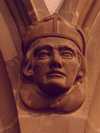 |
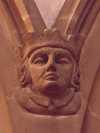 |
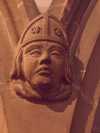 |
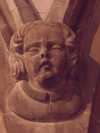 |
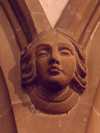 |
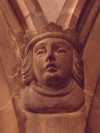 |
| Carved heads in the nave arches | ||
In the nave there are a series of carved heads where the hood-mouldings of the arches meet above the pillar capitals. They all appear to be kings, queens or bishops except for one on the extreme west side of the north aisle, which is the head of a child. Tradition said this was a local boy, Robert Lowe, as at the time of the work the masons lodged with the Lowe family, and left a likeness of one of their sons. However, Robert Lowe was only a few months old at this time, and his elder brother only two years old, so it is unlikely.
A War Memorial was installed after the First World War.
A faculty was granted in 1934 to remove pews and pave an area within the church. The pews at the south rear part were removed in 1991 in order to provide an informal carpeted area for parents with young children.
In 1994, on the occasion of the 150th anniversary of the present church, most of the aisle and vestry roofs were re-slated and the lead gutters renewed. The cost of £34,000 was met from the building restoration fund, interest on the sale of St Mary’s Beeston Rylands, local grants and an appeal to the public and local businesses, as well as events to celebrate the 150th anniversary.
In 1887 arrangements had been made with Humber & Co, the cycle manufacturers, to use their large mess room on Humber Road, Beeston for a Sunday School and for an adult service to be held on Sunday evenings. Mr George Hayes served as Superintendent. The number of children in the Sunday School grew from the original 36 to 400, so funds were raised and in 1899 a site on Queens Road was purchased for £350.
On 3 May 1900 the foundation stone of the Valley Mission was laid by the Rev R.D.Harries, Vicar, and the building was opened in October 1900. Apart from the chairs, all the interior fittings and furniture were made by parishioners. After Mr Hayes death in 1948 a lectern was bought in his memory, which is still used in the parish church. In 1960s the congregation began to dwindle and the Valley Mission closed in 1971. The building was sold for commercial use.
In the 1930s the Rylands area of Beeston developed rapidly and in 1938 land was purchased for a daughter church to be built. The War delayed the plans, but St Mary’s church was finally opened in July 1952, and in October the chancel was dedicated by the Bishop of Southwell, the Rt Rev F Russell Barry. Eventually the size of congregation dwindled and the number of services declined. On 28 April 1991 the Rev Stephen Lowe preached at the final Eucharist held there and the church was closed. Arrangements were made for the congregation to gather each Sunday for an Anglican communion service in the Methodist church on Victory Road. The St Mary’s building was sold to the Elim Pentecostal church and the money invested for the benefit of the church’s work throughout Beeston.
The Church Hall was burnt down on 5th November 2004. It was decided not to rebuild the hall, but rather to redesign the interior of the church, making it a much more multi-purpose building. As part of the refurbishment the pews were removed, a new organ was installed, the font was moved, new office and vestries created.


